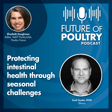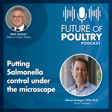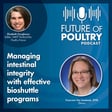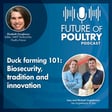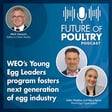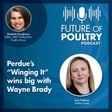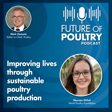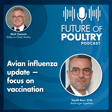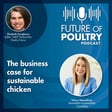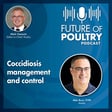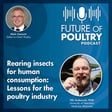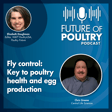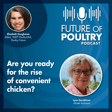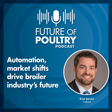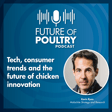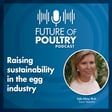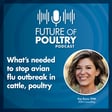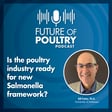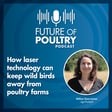Become a Creator today!Start creating today - Share your story with the world!
Start for free
00:00:00
00:00:01

Modulating the microbiome of the unhatched chick
Gina Sloan, founder of Agritx, and Mark Clements, editor-in-chief, poultry, discuss Agritx’s novel microbiome technology that helps chicks thrive and boosts bird performance.
Transcript
Introduction and Topic Overview
00:00:00
Speaker
Hello and welcome to the Future of Poultry podcast series.
00:00:12
Speaker
Hello and welcome to the Future of Poultry podcast. I'm Mark Clements, Editor-in-Chief Poultry with WhatGlobal Media, and today we're going to discuss regulating the microbiome of newly hatched chicks.
00:00:24
Speaker
To do that, we're going to look at the work of a small U.S. company, Agrotex. Agritex was founded in 2021 in North Carolina and I first came across them in early 2024. and I've been keen to catch up with them ever since, given that they work in an area that particularly interests me, the microbiome.
00:00:42
Speaker
Products to alter the microbiome are ever more commonplace, yet as far as I know, nothing's currently available that modulates the microbiome of the unhatched
Interview with Gina Sloan from Agrotex
00:00:51
Speaker
chick. This is where Agritex has something that I think is probably unique.
00:00:56
Speaker
And I'm delighted to welcome Gina Sloan, founder of Agritex, to the podcast. And she's going to tell us exactly what the company's been working on. Gina, hello. Great to talk to you again. How are you?
00:01:08
Speaker
Thank you, Mark, and thank you for having me on. So excited to be here and be able to talk about Agritex and what we've been up to lately. Delighted to have you here, Gina. Let's make a start.
00:01:18
Speaker
Tell us a little bit about yourself, if you would, about Agritex and how you came to set it up. Well, my background is in microbial control. So whether it's vaccines, antimicrobials, or food as medicine, really my passion lies in leveraging microbes and their environment to improve health measures overall.
00:01:41
Speaker
So our origin story is a little odd. My co-founder, who's Kevin Parrish, was actually utilizing antimicrobials to control microbes in the hatchery, but he was seeing really inconsistent results.
00:01:55
Speaker
So he came to me as a colleague, and we sat down and discussed what issues he was seeing and then went back and went through the literature to find if there was any reason why he would see these. And we realized that there were limited egg-based interventions on the market,
00:02:12
Speaker
And that the egg actually represented the very first start of the microbial problem.
How Does Agrotex's Product Work?
00:02:18
Speaker
And that's where it led us to a researcher named Tori Luft from the USDA, who had written a pivotal article describing how the eggshell microbiome is what dictates the microbiome of the hatched chick. So in his article, he described that it's more of this eggshell phenomenon where the microbes on the eggshell and less of the environment where the chick is raised is what sets off the trajectory of the microbiome for the chick.
00:02:47
Speaker
So we decided to formulate a product that would modulate the microbiome of the eggshell. And we're doing that with a spray-based system. And we understand that it's really odd and awkward to spray an egg. We've had a lot of input on that.
00:03:00
Speaker
But we felt that it was this unique opportunity to modulate and change that eggshell microbiome that would provide a true benefit to the industry by giving us a new potential for regulating that microbiome of the hatch check.
00:03:16
Speaker
Now that's really interesting. So your lead product is called F65. Tell us briefly what it is and how it came about. Well, F65 stands for egg coating formulation 65. So not a very sexy name, but it truly is what it is.
00:03:33
Speaker
And that is a combination of multiple nutritional ingredients. So ingredients that are already AFCO listed or FDA listed to be fed to poultry.
00:03:44
Speaker
And they include amino acids, vitamins, minerals, prebiotics, and probiotics. The entire formulation is meant to promote that healthy microbiome of the eggshell while also decreasing pathogens of concern and promoting nutrition for the embryo.
00:04:04
Speaker
Every single component was selected for ah dual purpose. The first is it had to be published to promote embryonic development of that developing chick.
00:04:15
Speaker
And the second was that it needed to have enhanced the healthy microbiome. So those two things had to be present for each component to be incorporated into the formulation.
00:04:26
Speaker
So the product feeds the embryo, F65 feeds the embryo. Is this a first of its kind? We believe that it is the first product that has been developed to utilize the eggshell to influence embryonic
Impact of F65 on Poultry Health
00:04:39
Speaker
development.
00:04:39
Speaker
In fact, on day of hatch, the chicks that come from Agritex treated eggs have altered immune system status and microbiomes than those of untreated eggs.
00:04:50
Speaker
This means that the overall approach that we wanted to go after of leveraging the eggshell, it does open up this new opportunity for poultry nutrition. So well beyond even this one formulation of F65, we can now leverage the eggshell to have multiple nutritional interventions for multiple end uses or end outcomes.
00:05:13
Speaker
So in in addition to the inclusion of amino acids and vitamins and minerals and prebiotics, what you're feeding the embryo is bacteria that would normally be found on the surface of an egg laid by a healthy hen, if I've understood correctly. Yes, that is correct. So we are primarily looking for driving those bacteria and those bacterial populations.
00:05:35
Speaker
on the eggshell and within the egg itself. When we think of the egg, we are really accustomed to thinking of those microbes. So like you said, we are trying to create those microbes on the eggshell, make sure they're there, make sure they're uniform so that each egg has the same start.
00:05:53
Speaker
ah Instead of having hen-to-hen variation or even layer flock to layer flock variation, you create a level set of that microbiome from the very beginning.
00:06:04
Speaker
So how do you select the bacteria that you use? So since our primary goal is to influence that microbiome, our bacteria were first selected to be able to survive incubation conditions of the setter and the hatcher.
00:06:18
Speaker
So that allowed us to narrow down our selection of microbes. And then they also had to have the unique ability to move across the eggshell and across the membrane and enter into the yolk sac.
00:06:31
Speaker
So up front, we selected for microbial species and then strains that were able to survive those conditions of incubation and move through and enter the yolk sac so that we have the best ability to have that chick internalize the yolk sac and have a direct influence on that microbiome development from that point forward.
00:06:54
Speaker
And the products applied within the hatchery as a spray? Correct. So as we apply it, it's applied before the egg goes into the setter. It is a one-time application, typically applied in the egg room.
00:07:07
Speaker
This allows us one-touch point. So it's just a one-time treatment, fairly easy to implement at the hatchery. It is a water-based spray. And they're right now we're applying them as they're on the farm trolleys before they go onto setter carts.
00:07:21
Speaker
And it works by crowding out pathogens. but So F65 was designed to crowd out pathogens of concern. And by applying beneficial microbes to the surface, we are allowing them to occupy the niches on the shell and within the embryo that would be occupied by pathogens otherwise.
00:07:42
Speaker
So we are out crowding them or out competing them. And we've been able to show that this has broad spectrum benefits across multiple pathogens of concern in the lab, including things such as avian pathogenic E. coli, enterococcus, and clostridia.
00:08:00
Speaker
And when we look at the microbe of the hatched chick and we look at the further grow out, we see that the treatment itself actually forces a different evolutionary path of the microbiome.
00:08:12
Speaker
where you start as a different chick and even during grow out, the microbiome is continuing to develop into a different microbiome than that of an untreated egg.
00:08:23
Speaker
And you see a predominance of lactobacillus and other beneficial microbes colonizing that GI tract even later on throughout that development cycle. But I seem to remember when we spoke before, and in addition to an improved microbiome, there are other benefits that that this brings about. And chicks at Hatch have shown altered cytokine expression and altered innate immune cell prevalence and indeed improved gut barrier function. Can you tell us more around that?
00:08:52
Speaker
So whenever we first started, we wanted to really understand what was going to happen with that hatched chick. And we believe that most of the benefits that we're going to talk about are derived in a result of that improved microbiome. But when we set out, we wanted to understand, you know, how is this impacting the overall health of the chicks? We looked at the immune system and there we did see an alter expression of cytokines in both the bursa and the spleen of the hatched chick, showing that we reduced bloodstream.
00:09:20
Speaker
pro-inflammatory cytokines and we increase anti-inflammatory cytokines. This change in cytokine profile is then linked to differences in immune cell prevalence. And specifically here, we're talking about heterophils and lymphocytes.
00:09:38
Speaker
And we saw an increase in lymphocytes, which are kind of like, why does that matter? It's been published in literature that if you have an increase in lymphocytes, It's actually an indication of improved gut barrier function that prevents the escape of pathogens of concern from that gut.
00:09:56
Speaker
Okay, so you've conducted field trials on broilers that were hatched from eggs that were sprayed with F65. Briefly, what did you find? So outside of our small scale PIN trials that we've looked at, we had the opportunity with a partner to conduct a 1 million egg trial that had 500,000 Agri-Tex eggs and 500,000 control eggs up front. First of all, from the very beginning, we actually saw an improvement in Hatch of 1.5% on average. But when you look at matched flocks, over 3%.
00:10:26
Speaker
And then we placed those hatch chicks on four different farms that had known challenge issues with both Enterococcus and E. coli. So those farms were paired such that half the houses were controls and half the houses were Agritex houses.
00:10:41
Speaker
So same farmer just split houses on those. 16 control houses and 18 agritex houses overall. And during a 50-day grow out, four out of the 16 control houses experienced challenges, whether it was enterococcus or avian pathogenic E. coli. And interestingly, none of the agritex houses experienced the challenge.
00:11:04
Speaker
So this then demonstrates that we are modulating that immune system even in real grow out and production parameters. Since we didn't have those same disease challenge problems, we did see an improvement in livability.
00:11:20
Speaker
And because healthy birds simply gain weight better, those birds also weighed more. Overall, we did see an improvement in hatch, an improvement in livability, and then in weight gain.
00:11:31
Speaker
all from that one-time upfront treatment in the egg room. And we are in the process right now of repeating those results, and we're very grateful for all of our trial partners for helping us along the way.
00:11:42
Speaker
Well, that sounds
Market Launch and Future Plans
00:11:43
Speaker
great. But I'm sure all our listeners are going to want to know, is F65 commercially available? And if not, when and where will they be able to get hold of it? When will it be commercially launched?
00:11:55
Speaker
So we're actually looking to commercially launch this year by June. So we are focused on the U.S. market right now in 2025 just to get our feet under us and make sure that everything's going well. At the same time this year, we're going to start trials in South America to make sure that we can reproduce the same results that we saw here in the U.S. in the South American growing conditions.
00:12:16
Speaker
Gina, great. That all sounds really rather wonderful. But the last time that we spoke, you mentioned that great things were on the horizon for Agritex, but that there was still a degree of confidentiality around what you were doing, hence us not speaking until...
00:12:32
Speaker
today. What's happened over the last 12 months or so? Could you tell us? So once again, thank you for keeping in touch over the full 12 months. I appreciate that. So since we last chatted, we've had a lot of things that have occurred. One is our journey over the last 12 months has taken us to scale product from bench to production level.
00:12:51
Speaker
And we feel really confident that we're ready for the market. We finalized the F65 formulation. So last time we spoke, it was still a little bit of flux in that formulation.
00:13:02
Speaker
We've been able to have that initial trial and begin to reproduce those results. We've also seen that our IP has been converted internationally. So we're really confident in our market. We're really confident in our product at this time, and we're ready to move forward with commercial sales of it.
00:13:21
Speaker
Fantastic. Gina, please do keep us up to date.
Conclusion and Future Episodes
00:13:24
Speaker
Listeners, we're going to wrap up here. Gina, thank you so much for joining us today and for sharing of your work with us. I'm absolutely really delighted that we've been able to catch up and share what you've been working on.
00:13:38
Speaker
I hope that we can do it again soon. I hope so too. So thank you so much for having me and we look forward to how everything grows and being in touch. Thank you. Listeners, if you're particularly interested in the microphone biome, you can find lots of articles about it on whatpoultry.com.
00:13:55
Speaker
Once again, Gina, thank you so much for joining us. Listeners, don't forget to look out for future editions of the Future Poultry podcast. Goodbye.
